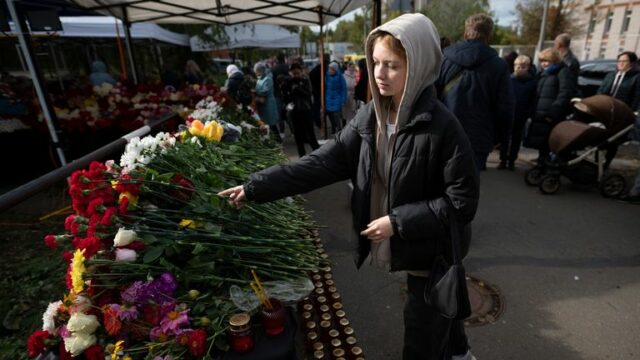
School Shooting in Izhevsk: A Specter of Further Anti-State Violence in Russia?
Publication: Eurasia Daily Monitor Volume: 19 Issue: 145
By:

Set against the backdrop of the war in Ukraine, school shootings in Russia—such as the one that took place in Izhevsk and claimed the lives of 15 people (11 children and four adults) on September 26—seem like background noise deflecting from the main issue (Mk.ru, September 26). Yet, it is important not to lose sight of domestic developments that may influence the larger situation, particularly as people begin to speculate about a post-Putin future. The killer, 34-year-old Artem Kazantsev, was a graduate of school Number 88, where the shooting happened; an advocate of Nazi ideology; and undergoing treatment for a host of psychological issues.
A standard reaction to school shootings wherever they happen is to dismiss them as mental illness, but this action was also consistent with a growing pattern of anti-state violence, which adds a little more nuance. The massacre in Izhevsk in Udmurtiya region was the latest in a series of education institution–based violent incidents in Russia. In 2018, the “Russian Columbine” took place at a school in the city of Kerch on the occupied Crimean peninsula (see EDM, October 22, 2018). In 2018, a spate of high school knife attacks plagued various cities across Russia (see Commentaries, November 9, 2018).
A shooting in a Kazan school in May 2021 killed nine people and injured 20 (Ria.ru, May 11, 2021). Yet another shooting happened at Perm State University in September 2021, which killed six and injured 20 (Ria.ru, September 20, 2021). Granted, this kind of violence has been conceivably exacerbated by the pandemic, but the sheer number of school shootings in a country in which they were previously unknown should give one pause for thought as to the connections among them.
School shootings in Russia are plausibly considered manifestations of anti-state violence for several reasons. First, the “state” is an abstraction, and people encounter it in different ways. Perhaps the primary and most direct way in which young people interact with it is through state-mandated education, in which teachers and institutions become representatives of broader and more complicated institutions that dominate their lives. Second, in Russia, state schools have become vehicles for state-centered propaganda, including selective histories, complemented by the incitement of patriotic sentiments in various ways, including through history curricula and the lentochka (Saint George’s ribbon). (See, for instance, Rossiskaya gazeta, April 22, 2015.)
Third, some of the shootings appear to have had connections to the neo-Nazi underground, which calls for a violent overthrow of the Russian state and the establishment of an ethno-state. Fourth and final, Russian President Vladimir Putin’s regime has consistently promoted youth radicalism and involvement in paramilitary gangs and organizations (see EDM, August 10). Thus, it is no surprise that such aggression manifests itself in attacks on the state. The hypothesis that Russian school shootings are different in meaning and form to shootings in other countries, most notably the United States, therefore finds support in the empirical record.
The shooting in Izhevsk conformed to this pattern as well. Kazantsev was allegedly dressed in black and white with a red swastika on his T-shirt. The school was Number 88, which in neo-Nazi parlance stands for the eighth letter of the Latin alphabet repeated once—that is, “HH” or “Heil Hitler” (Novaya gazeta, September 26). Similar to other countries, Russia officially condemns race-based violence and ideologies of hate. However, Moscow also openly promotes and funds promoters of such views abroad (Shevkovtsov, Tango Noir: Russia and the Western Far Right, 2017) while clandestinely propagating them domestically (Small Wars Journal, June 14; YouTube, August 22).
Additionally, other incidences of anti-state violence in Russia have occurred recently, specifically from Russian youth, consistent with such interpretations of school shootings. One incident that comes to mind was the attack on a Russian Federal Security Service (FSB) office in the city of Archangelsk, where the attacker’s words—that the FSB “fabricates cases and tortures people”—revealed wider frustrations with the entire system of justice enforcement (see Commentaries, November 9, 2018).
Moreover, characterizing such violence in Russia, such as the recent shooting in Izhevsk, as “anti-state” makes sense against the background of the mobilization, which is currently dominating headlines. The Kremlin’s “partial mobilization” so far has been met by a state that was seemingly ill-prepared to equip and train such a large number of people for war (see EDM, September 29). Some Russian citizens also perceive the mobilization, similar to conscription drives before, as being ethnically discriminatory—explaining why it has been met with protests and even attacks on recruitment offices in Buryatia, Yakutia and Dagestan (see EDM, September 29).
Whether these shootings should be considered examples of anti-state violence, they certainly point to an additional problem: the proliferation of guns among the general populace. This makes the current situation much more volatile—and potentially deadly. Between the manifestations of anti-state violence, ethnic grievances in Russian regions and the proliferation of firearms available to the public, perhaps the most likely scenario for a post-Putin Russia is not a new autocracy but a second civil war. Indeed, it may already have started.



